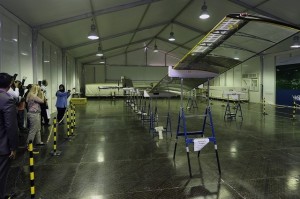2014-09-25
In a September 25, 2014 Press Release from Airbus Defense and Space, the flight of the Zephyr over the UAE was highlighted.
Airbus Defence and Space announced today that a team comprising engineers from the Emirates Institution for Advanced Science and Technology (EIAST) and the Airbus Zephyr program has successfully completed the first civil flight of the Airbus Zephyr High Altitude Pseudo-Satellite (HAPS).
The flight, completed last week in Dubai, achieved the highest altitude ever reached in the United Arab Emirates, 61,696 ft., and by completing a full day / night cycle of operation also recorded the longest flight of any aircraft within the UAE.

The flight was approved by the Dubai Civil Aviation Authority (DCAA) and represents the first time that a HAPS operation has been authorised by a civil authority. “DCAA are proud to have been able to support EIAST and Airbus to complete the first flight of a High Altitude pseudo-satellite in the UAE.” said Michael Rudolph of the Dubai Civil Aviation Authority (DCAA).
He went on to explain the importance of the operation, “By working closely with EIAST, Airbus, DCAA, Sheikh Zayed Centre and our military Air Force colleagues we have been able to complete not only the first flight of such a novel air vehicle but also safely manage a flight to above 60,000 feet close to one of the three busiest airports in the world. This shows that Dubai and the DCAA hold a leading position in developing and implementing procedures and policies for the safe and efficient operation of UAVs within the region”
Sarah Amiri, EIAST Programme manager for the Advanced Aerial Systems Programme said “This has been an outstanding cooperation between Airbus, EIAST and the Dubai CAA and we are delighted that within a few short months we have integrated, tested and flown such an advanced unmanned aircraft and been able to demonstrate a number of applications that are critical to Dubai and the wider world.”
“The flight in Dubai demonstrated the ability of Zephyr to operate in regions of the world’s most crowded airspaces”, said Chris Kelleher, Technical Director of the Airbus HAPS program.
”I am immensely grateful for the support and diligence of the Dubai CAA and other authorities in working closely with the combined EIAST Airbus Team to ensure a safe and successful stratospheric flight. With all systems working well in temperatures ranging between +40oC and -80oC and up to a maximum altitude of 61,696ft, this flight further reinforces confidence in Zephyr for users and regulators.”
According to a story published in the UAE publication The National and published on September 24, 2014 (excerpts only for the full article click on the link below).
It is thought that the drones, which fly in the earth’s stratosphere high above commercial aircraft, could be used as cheaper, more easily customizable satellites, or even used to boost internet connections in remote parts of the country.
“It’s similar to a satellite,” said Salem Humaid Al Marri, the assistant director general for scientific and technical affairs at EIAST.
“But you can bring it down, change the payload and put it back up again. It’s very flexible, in ways that a satellite is not.”
The drone, which is known as a High Altitude Pseudo Satellite (Haps), is a lightweight, unmanned aircraft that weighs not more than 34 kilograms.
It has a wingspan of 18 metres and is able to fly at an altitude of 65,000 feet, although it flew at 61,500 feet during a test flight.
The propeller-powered drone uses electricity generated from high-tech solar panels across its wings, and it can remain airborne for about two weeks without having to land…..
Mr Al Marri said he hoped the UAE would have at least five of the drones eventually, which would not only fulfill an imaging role but would also serve as stationary communications satellites, boosting internet and telecommunications access in remote areas of the country.
“I’d say we’re 10 years away from that,” he said.
“But we’re investing in these technologies now, so we can provide such services in the future…..”
“These aircraft act as temporary, cheap satellites that are flexible in terms of what payload you decide to carry. But they cannot take the place of a real satellite.”
Air-traffic congestion is one of the biggest challenges that EIAST expects to face.
“It flew right next to one of the world’s top three busiest airports, and in the busiest airspace in the world,” said Ms Amiri.
“That was the biggest concern, but the aircraft performed really well.”
http://www.thenational.ae/uae/technology/uaes-pseudo-satellite-drone-has-successful-test-flight

